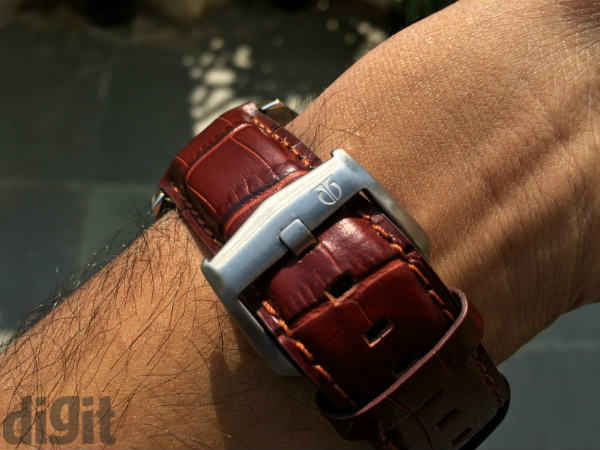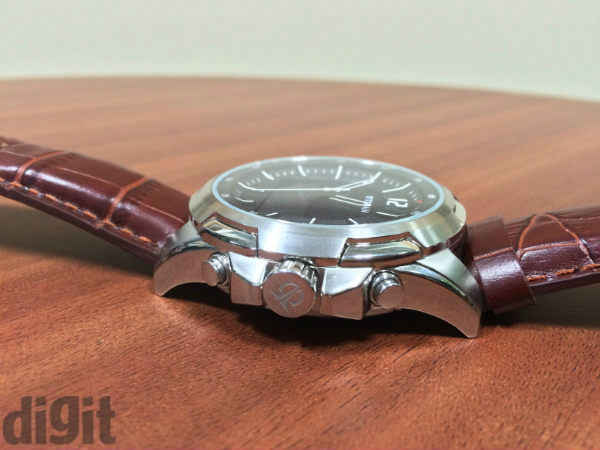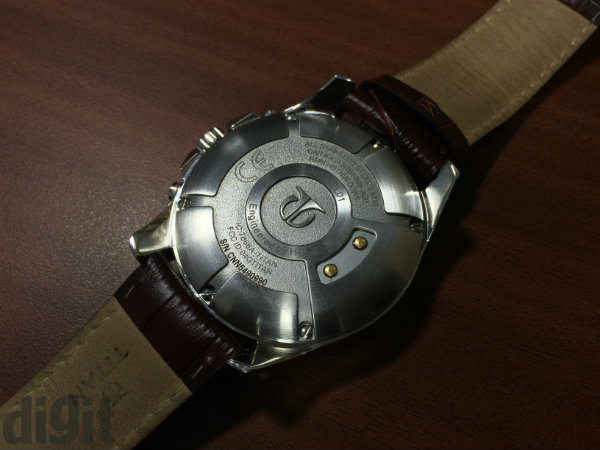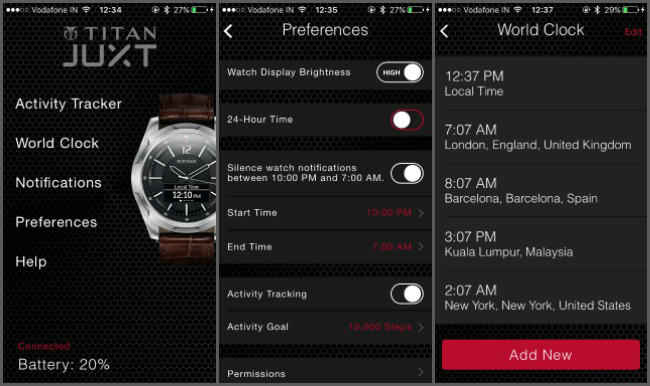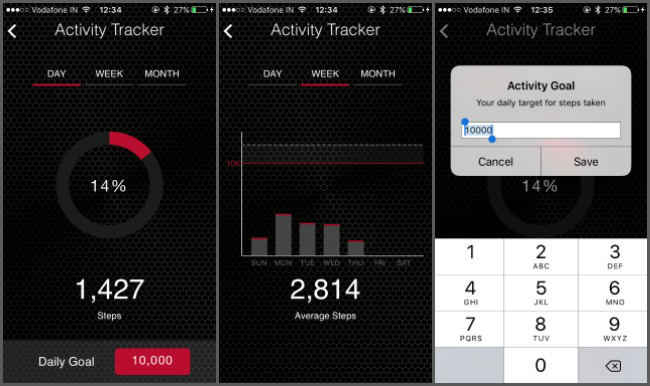Titan Juxt Review : Of traditions and becoming smart
They say that the relationship between a man and his wristwatch is more of emotion than that of precision. The Juxt, with the added sense of smart, forcibly brings the precision in question. Sure, it isn’t the perfect combination of analogue and digital, but it has its strengths. It shows you the essential notifications. The pedometer is not the most accurate, but it does suffice nonetheless, on an average scale. The battery life is particularly helpful for the present generation that has more charging adapters in life than the number of music tracks on phone. Overall, I can conclude that the Juxt is not exactly for me. I can visualise my father absolutely liking this device, as it somewhat suits his lifestyle. The designing of the watch, however, may see a few disgruntled perfectionists. Overall, the Titan Juxt is a worth first attempt, but has a very wide room for improvement.
Keeping all of this in mind, Titan has introduced the Juxt, a smartwatch with the bearings of a traditional wristwatch along with the addition of a small display on the watch dial. The name, as Titan stated, stands for ‘juxtaposition’. The watchmaker has collaborated with HP on the technology front, while designing the watch by itself. And, while it does look like a decent, traditional wristwatch by Titan, its standing as a smartwatch is what was in question. Here’s what I found, in my five days with the Titan Juxt.
Build and Design
The build of the Titan Juxt is quite elegant, to begin with. We got the stainless steel version of the Titan Juxt, along with a mahogany genuine leather wrist band. Build-wise, the Juxt is really sturdy. The stainless steel body, along with its added sense of weight, gives it the definition that a standard wristwatch carries with itself, while the honeycomb pattern, concentric rings and time markings give it a casual tone bordering at being sporty. We saw ourselves divided on opinion, with adjectives defining the Juxt ranging from “hideous” to “traditionally elegant”. Personally, my opinion fell somewhere in the middle. While the Juxt, according to me, is certainly not hideous, it is not the best wristwatch in terms of design, if you are spending over Rs. 15,000 on a wrist accessory. Add to that, the display does look a bit out of place on the watch, but is not entirely obtrusive on the overall design.
The wrist strap that Titan offers with the Juxt is one of its genuine leather variants, and with Titan being a traditional watchmaker, you can simply walk into a Titan store, choose any strap of your choice, and get it replaced at your convenience. The dial, however, seems like an awkward mix between muscle, elegance and sportiness. In a bid to appeal to a wider section of the audience, what Titan has ended up with is a traditional wristwatch chassis with a tiny monochrome OLED display, skeletal watch hands and large dashes depicting the hour, with only ‘12’ written in figure. Titan’s style of figuring ‘12’, the large dashes, skeletal hands and the concentric circles on the dial got me confused – does this fit perfectly in corporate meetings, or do I wear it on a drive-out with friends? I actually ended up choosing neither, wearing it on random occasions. The Juxt is not a sudden head-turner the way an Apple Watch is, but it fits a reasonable variety of clothing styles and colours. The lack of a concrete style statement to the watch may have been exactly what Titan wanted, but it will not please the purists in terms of the excellence of a wristwatch.
The extra weight is also a matter of concern. While the Juxt weighs confidence and assurance on your wrist, it does get uncomfortable in the long run. I love wrist accessories, but I like to see a subtle, understated, light weight elegance about them. While the Juxt feels very well made and constructively planned, it feels as if Titan overstepped the line by a whisker, and ended up making the Juxt heavy, rather than heavy enough to imbibe the premium factor. It was probably essential, to pack in the pedometer measuring the number of steps and all the technology required for it, but ease of wearing is crucial for wristwatches, and the Juxt misses out on that.
As for the OLED display, maybe Titan could not have placed it any better than this without disturbing the smooth flow of design and mechanism on the Juxt. Overall, the Juxt builds on the prospect of a traditional wristwatch with the addition of ‘smart’ aspects. My colleague raised a pertinent issue here, that in process of providing notifications and activity statistics along with the aesthetics of a traditional wristwatch, the Juxt may end up becoming neither, but only a glorified notification panel. While it did not exactly end up being that, here’s what I found it to be.
The ‘analogue’ smartwatch
In terms of the wristwatch, the Juxt felt as good as any worthy Titan wristwatch does. It comes with the satisfaction of you owning a product that defines your lifestyle, only with a wee bit of confusion. The Titan Juxt, as mentioned earlier, somewhat loses its cue on the proper definition of a lifestyle trend, and that was justified by the different opinions it garnered. In terms of operation, there is not much that you can point out as ‘wrong’ over here. The second hand is a milimeter off the accurate mark, but that is nothing that a watchmaker cannot calibrate. Titan states that the Juxt’s analogue operations will run for two years without any hiccup in terms of battery and mechanism, and we totally believe so. The steel used on the watch, too, feels premium enough to urge you in pulling out a pair of Salvatore Ferragamo to complement it, and after ten inadvertent direct bumps on to rough wall surfaces, the glass is yet to pick up a single scratch apart from a microscopic speckle towards the bottom right of the glass.
Until now, everything seemed good about the Juxt. It is only when you shift your attention to its ‘smart’ abilities that you begin questioning. The Titan Juxt’s minuscule OLED display shows you notifications for social media updates, messages, emails and calls. You will also be notified through vibration, the intensity of which can be toggled between Low and High. The Titan Juxt also comes with a pedometer to give you a step counter – its only work as an activity tracker. Titan insists that it deliberately kept the smart activities to a bare minimum, giving its users only what they desire, according to market surveys. You can also set five locations across the world to see the local times. The functioning, too, is quite simple.
To pair it with your smartphone, you will need to download the Titan Juxt app on your phone. Once you tap on ‘Pair’, you will be prompted to press the top button on your watch. A passcode shows up on the display, which you can key in on the app, and you are ready to roll. The app has a simple layout (there’s only so much that you can do here, anyway) that shows up five tabs – Activity Tracker, World Clock, Notifications, Preferences and Help. The Activity Tracker shows you the number of steps that you have taken spread across daily, weekly and monthly charts. World Clock will allow you to add five locations, and under Notifications, you will see a neatly laid-out arrangement of Messaging, Mails, and other third party apps that push notifications to your phone. Preferences allow you manage how you want your watch to behave, like managing display brightness, choosing between 12-hour and 24-hour time formats, silencing the watch, and managing permissions. Vibrations for different classes of push notifications can be controlled from the notifications menu itself.
While the Juxt works as a basic notification relay system, it belies the prime definition of a smartwatch. A smartwatch, in the true sense, should give you ample control of your smartphone so that you do not require to whip it out unless you wish to contact someone yourself, or look something up. While the Juxt gives you notifications, there is no way for you to respond to them. For call notifications, you can reject them from the watch itself, but there is no way to send quick responses or voice notes from the watch. Of course, Titan meant it to be this way, but after using the Apple Watch on a regular basis, I found the Titan Juxt tedious.
Another deterrent is the always-running app on your smartphone. With increasing amount of concern regarding background apps hogging the resources on smartphones, the Titan Juxt app needs to always remain on for the watch to remain smart. The Juxt, however, will find its own audience. My father, for instance, does not like the number of taps it takes for a smartwatch to reach its right setting. For him, the Titan Juxt would be a sensible device, as he can see the notification briefs on his smartwatch, decide if he needs to respond to the same, and reach out for his smartphone. His relation with technology is purely pragmatic, and on that note, the Titan Juxt suffices the essentials that he asks for. Nothing more.
For someone like me, however, the Juxt is a generation beyond. I like the outlook that Titan has behind the Juxt, but there are a few aspects where I tend to disagree. For one, the neutral stance of the Juxt’s watch face deceives, and till date, I remain undecided if it indeed goes with my favourite blue kurta. Push message notifications are just not enough for me, and more than that, the Juxt relayed the notifications at a slight delay than my smartphone. By then, I was already hunting down the email on my smartphone, and the added notification only served to annoy me at peak work hours.
Battery Life
It is here that the Titan Juxt proves to be excellent. The Juxt ran for the full five days and a little more, as promised by Titan. I did not need to wake up everyday and plug it in to charge, and leaving for work on Monday morning with 100% charge will see you through the entire week, almost certainly. Of course, there is nothing much to drastically drain battery, and that only makes the Juxt more relevant for everyone looking for a more simple take on the operations of a smartwatch. The Titan Juxt, in short, works as a pleasant timekeeper who occasionally lets you know that its time to leave for home.
Bottomline
They say that the relationship between a man and his wristwatch is more of emotion than that of precision. The Juxt, with the added sense of smart, forcibly brings the precision in question. Sure, it isn’t the perfect combination of analogue and digital, but it has its strengths. It shows you the essential notifications. The pedometer is not the most accurate, but it does suffice nonetheless, on an average scale. The battery life is particularly helpful for the present generation that has more charging adapters in life than the number of music tracks on phone. Overall, I can conclude that the Juxt is not exactly for me. I can visualise my father absolutely liking this device, as it somewhat suits his lifestyle. The designing of the watch, however, may see a few disgruntled perfectionists. Overall, the Titan Juxt is a worth first attempt, but has a very wide room for improvement.

